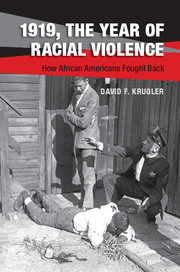Book contents
- Frontmatter
- Dedication
- Contents
- Acknowledgments
- Source Abbreviations and Usage Note
- Introduction
- 1 World War I and the New Negro Movement
- 2 “We Return Fighting”
- 3 Fighting a Mob in Uniform
- 4 Blood in the Streets
- 5 Armed Resistance to the Courthouse Mobs
- 6 Armed Resistance to Economic Exploitation in Arkansas, Indiana, and Louisiana
- 7 “It Is My Only Protection”
- 8 The Fight for Justice
- 9 The Fight for Justice
- 10 Fighting Judge Lynch
- Conclusion
- Bibliography
- Index
- References
3 - Fighting a Mob in Uniform
Armed Resistance in Washington, D.C.
Published online by Cambridge University Press: 05 December 2014
- Frontmatter
- Dedication
- Contents
- Acknowledgments
- Source Abbreviations and Usage Note
- Introduction
- 1 World War I and the New Negro Movement
- 2 “We Return Fighting”
- 3 Fighting a Mob in Uniform
- 4 Blood in the Streets
- 5 Armed Resistance to the Courthouse Mobs
- 6 Armed Resistance to Economic Exploitation in Arkansas, Indiana, and Louisiana
- 7 “It Is My Only Protection”
- 8 The Fight for Justice
- 9 The Fight for Justice
- 10 Fighting Judge Lynch
- Conclusion
- Bibliography
- Index
- References
Summary
During the Great War, the 372nd Infantry Regiment, Ninety-third Division, faced two enemies: its white officers and the Germans. The regiment was formed from four existing black National Guard units, including the First Separate Battalion of the District of Columbia. Arriving in France in mid-April 1918, the 372nd soon found itself in the trenches of the Western Front, first in the Argonne West sector. The regiment took part in the Meuse-Argonne offensive, going “over the top” on September 28, with artillery shells “falling like hail.” The 372nd helped force a German retreat, capturing sixty enemy soldiers and many artillery cannons. It stayed on the front for more than a week, until its relief by a French regiment.
Whether in or out of the trenches, the black enlisted men and officers of the 372nd chafed under their white command. In a breach of military protocol, Colonel Glendie Young ordered the officers to eat with enlisted men. “I wouldn’t make a god-damned one of these black sons-of-a-bitch an officer if I didn’t have to,” Young complained to other white officers. No wonder Rayford Logan, a newly commissioned black officer, called the colonel a “Negro-hater.” Young was soon transferred, but his replacement promptly asked General John J. Pershing to remove the regiment’s black officers, claiming that “racial distinctions which are recognized in civilian life naturally continue to be recognized in military life.” Although Pershing rejected the request, the regiment’s deteriorating morale alarmed French general Mariano Goybet, who questioned the unit’s combat readiness due to these racial tensions.
- Type
- Chapter
- Information
- 1919, The Year of Racial ViolenceHow African Americans Fought Back, pp. 66 - 98Publisher: Cambridge University PressPrint publication year: 2014



